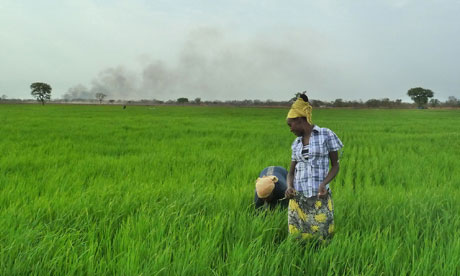Land grabbers: Africa's hidden revolution
Vast swaths of Africa are being bought up by oligarchs, sheikhs and agribusiness corporations. But, as this extract from The Land Grabbers explains, centuries of history are being destroyed

Employees of Saudi Star work in a rice paddy in Gambella, Ethiopia. The government wants to resettle thousands of families away from fertile land. Photograph: Jenny Vaughan/AFP/Getty Images
Omot Ochan was sitting in a remnant of forest on an old waterbuck skin and eating maize from a calabash gourd. He was lean and tall, wearing only a pair of combat pants. Behind him was a straw hut, where bare-breasted women and barefoot children cooked fish on an open fire. A little way off were other huts, the remains of what was once a sizable village. Omot said he and his family were from the Anuak tribe. They had lived in the forest for 10 generations. "This land belonged to our father. All round here is ours. For two days' walk." He described the distant tree that marked the boundary with the next village. "When my father died, he said don't leave the land. We made a promise. We can't give it to the foreigners."
Our conversation was punctuated by the rumble of trucks passing on a dirt road just 20 metres away. The dust clouds they created wafted into the clearing and rained down on the leaves on the trees. Beyond the road huge earth-diggers were excavating a canal. Omot watched them: "Two years ago, the company began chopping down the forest and the bees went away. The bees need thick forest. We used to sell honey. We used to hunt with dogs too. But after the farm came, the animals here disappeared. Now we only have fish to sell." And with the company draining the wetland, the fish will probably be gone soon, too.
Gambella is the poorest province in one of the world's poorest nations – a lowland appendix in the far south-west of Ethiopia. Geographically and ethnically, the hot, swampy province feels like part of the new neighbouring state of South Sudan, rather than the cool highlands of the rest of Ethiopia. Indeed, Gambella was effectively in Sudan when it was ruled by the British from Khartoum, until 1956. For the half-century since, the government in Addis Ababa has ruled here, but it has invested little and cared even less for its Nilotic tribal inhabitants, whose jet-black skin and tall, elegant physique mark them out from the highlanders. The livestock-herding Nuer, who frequently cross into South Sudan, and the Anuak, who are farmers and fishers, are peripheral to highland Ethiopia in every sense.
Only three flights a week go to the provincial capital, also called Gambella. When you get there, there are no taxis, because there is no demand. The road from the airport is a dirt track through an empty landscape. Gambella town is a shambles. Its population of 30,000 has no waste collection system, so garbage piles up. The drains don't work, public water supplies are sporadic and electricity is occasional. There are few public latrines. The couple of paved roads are heavily potholed and give out before the town limits. My billet, the Norwegian-built guest house at the Bethel Synod church, was probably the dirtiest, bleakest and most ill-kempt building in which I have ever rested my head. The only vehicle in town for hire was a 40-year-old Toyota minibus of dubious roadworthiness, with a crew of three. I took it.
Of late, the central government in Addis Ababa has stopped pretending that the province of Gambella doesn't exist. It now seems intent on taming a populace that might prefer rule from Juba, the capital of South Sudan. In practice, that means bringing in foreign agribusiness and collecting the province's dispersed population in state-designated villages, while their forests, fields and hunting grounds are handed over to outsiders. In the service of capitalism, the Gambella "villagisation" programme will relocate a domestic population much in the manner of Stalin, Mao and Pol Pot.
I set out along the only road south from Gambella town to find the land grabbers. On the outskirts, as we hit the dirt, my driver decided to pick up a dozen hitchhikers. From then on, we were the local bus service. To an outsider, much of the province looks deserted. For miles, the only obvious sign of human activity was the odd cellphone tower, usually with a generator to power it and a native guard. But there were hidden villages in the bush. Their members would sit by the roadside trying to sell mangoes and other fruit to any vehicles that passed. Mangoes cost less than three cents each and the price had halved by late afternoon. Soon after the small town of Abobo, the road passed through a landscape of ash, smoke and charred trees. This was land newly acquired by my first land grabber – Sheikh Mohammed Hussein Ali Al Amoudi, a Saudi oil billionaire with large holdings in Ethiopian plantations, mines and real estate. In 2011, Fortune magazine put his wealth at more than $12bn. Ethiopian-born, he is a million-dollar donor to the Clinton Foundation and also a confidant of Ethiopia's prime minister, Meles Zenawi, and his ruling party, which had granted a 60-year concession on 10,000 hectares of Gambella to Amoudi's company, Saudi Star.
Amoudi has been eyeing agriculture since the world food price spike in 2008 sent Saudi Arabia into a spin about its food supplies. He is intent on shipping most of his intended produce, including in excess of a million tonnes of rice a year, to Saudi Arabia. There, he has been feted by the king for making investments abroad to keep the kingdom fed. To smooth the wheels of commerce, Amoudi has recruited one of Zenawi's former ministers, Haile Assegdie, as chief executive of Saudi Star.
Saudi Star's concession is based around the Alwero dam, built in the 1980s to irrigate a state cotton farm that never happened. The dam's rusting sign still advertises the consulting services of Soviet engineers Selkhozpromexport. Amoudi is digging a 30km canal from the dam to irrigate rice paddies. Once the old state farm is watered, he wants to expand to at least 250,000 hectares, to grow sunflowers and maize.
At the gate of the Saudi Star compound, I watched soldiers usher in giant Volvo trucks and Massey Ferguson tractors and workmen starting to replace the temporary buildings with new permanent structures. Close by, they were laying an airstrip in a recently made clearing in the forest. Nobody at the company here or in Gambella town would talk to me. Perhaps they thought there was nothing to add to their boss's media statement that "land grabbing poses no harm on the environment or on the local community".
Our next hitchhikers were a couple of schoolgirls who wanted a lift to their home 2km away. It was there, in a small clearing in a forest by the road, where we found Omot Ochan in his combat pants, describing how Amoudi and his company were destroying his world. Hearing his testimony of ancestral connection with this patch of forest, and his determination to keep it, I was struck by how most westerners have lost any sense of place and attachment to the land. I move around all the time and buy and sell houses without feeling ties to the soil. But here in Gambella, their land is like their blood. It is everything. And to lose it would be to lose their identity.
Omot insisted Saudi Star had no right to be in his forest. The company had not even told the villagers that it was going to dig a canal across their land. "Nobody came to tell us what was happening." He did remember officials from the "villagisation" programme dropping by to say the families should go to the new village at Pokedi, across the River Alwero from Saudi Star's compound. But that was all. Omot had no doubt the purpose of the new village was to clear them and others off land taken from them to give to Saudi Star. So far, his family and their neighbours had refused to go, even though their children walked to the school at Pokedi on a Monday morning and didn't return until Friday evening.
"In our culture, going to a different place is unusual. You get different people and there is quarrelling," he told me, as his children gathered and grabbed the remaining maize. "We should remain in our own area. We won't go unless we are forced. God gave us this land." Another truck rumbled past, spraying dust over the tiny forest community now ostracised by its own government and under siege from a Saudi billionaire. After the truck had gone, I noticed a large, dead stork in the road. A woman headed off down the road with a bucket, on a long walk to find water.



Nessun commento:
Posta un commento